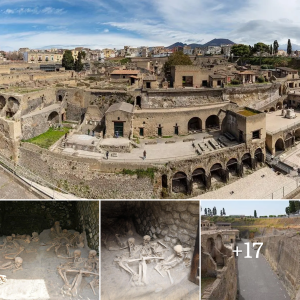A group of Iron Age Celts buried a woman about 2,200 years ago in what is now Zurich, Switzerland.
Bedecked in a fine woolen dress and shawl, sheepskin coat, and a necklace made of glass and amber beads, researchers believe she performed little if any hard labor while she was alive. It’s estimated she was around 40 years old when she died, with an analysis of her teeth indicating a substantial sweet tooth.

Adorned in bronze bracelets and a bronze belt chain with iron clasps and pendants, this woman was not part of low social strata. Analysis of her bones showed she grew up in what is now modern-day Zurich, likely in the Limmat Valley.

The archaeologists were especially intrigued by the clasp on the woman’s necklace. Both ends of the necklace had a garment clip known as a brooch that allowed her to wear the string of blue and yellow glass and amber beads, they said in a statement

Most impressive, besides her garments and accessories, is the hollowed-out tree trunk so ingeniously fixed into a coffin. It still had the exterior bark intact when construction workers stumbled upon it, according to the initial 2017 statement from Zurich’s Office of Urban

According to a statement released shortly after the discovery, workers uncovered the grave while carrying out a construction project at the Kern school complex in Zurich’s Aussersihl district. Although the site was considered archaeologically significant, most prior findings dated back to the sixth century AD.

As Geggel notes, a unique exception was the grave of a Celtic man discovered on the school grounds in 1903. The man, like the woman, was buried approximately 260 feet away and displayed signs of high social status, including being buried with a sword, shield, spear, and dressed in full warrior attire.
Given that both were buried around 200 BC, the City Office for Urban Development suggests it is “highly likely” they knew each other. According to the 2022 statement, researchers conducted a comprehensive assessment of the grave and its occupant soon after the discovery.
Over the past two years, archaeologists have documented, salvaged, preserved, and evaluated various goods found in the grave, while also examining the woman’s remains and performing isotope analysis on her bones.

The completed assessment now “paints a fairly precise picture of the deceased” and her community, according to the statement. Isotope analysis revealed that the woman grew up in the Limmat Valley of present-day Zurich, meaning she was buried in the very area where she likely spent much of her life.
While previous archaeologists had identified evidence of a nearby Celtic settlement dating to the first century BC, researchers believe the man and woman belonged to another, smaller settlement yet to be discovered.
Celts are often associated with the British Isles. In reality, Celtic tribes covered much of Europe, settling in Austria, Switzerland, and other countries north of the Roman Empire’s boundaries, according to Adam H. Graham for Afar magazine.
From 450 BC to 58 BC—the exact period in which the tree coffin woman and her future male counterpart lived—La Tène, a “wine-guzzling, gold-designing, multi-gendered/nude-warring civilization,” flourished in the region of Lake Neuchâtel in Switzerland.
Sadly for these pleasure-seeking Celts, Julius Caesar’s invasion abruptly ended their festivities, paving the way for Rome’s eventual enslavement of most of Europe.





